| Home > Policy > White Paper, Notice, Announcement > White Paper > EDUCATIONAL STANDARDS IN JAPAN 1971 > CHAPTER |
||
Increased enrollment in institutions of higher education is a recent phenomena which can be seen not only in Japan but also in other major countries.
Although the absolute number of students enrolled in institutions of higher education is greatly different from one country to another, a tendency toward increase is commonly seen.
In terms of the number of students in institutions of higher education per 1,000 inhabitants, the U.S.A. ranks first, followed by the U.S.S.R. and Japan. But in the recent years the annual average rate of increase has been low in the U.S.A. and the U.S.S.R., while it is high in Britain, France and Japan.
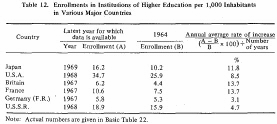
Note: Actual numbers are given in Basic Table 22. Basic Table 22
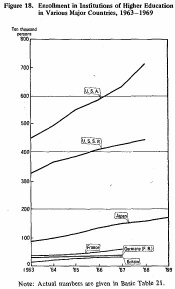
Note: Actual numbers are given in Basic Table 21. Basic Table 21
As for distribution of enrollment by field of study, the proportion of students in humanities and social sciences is generally very high, being over 50% in Japan, the U.S.A. and France, although in the U.S.S.R. science students account for more than 50%. It should also be noted that, except for France, students in education account for higher percentages of total students than in Japan.
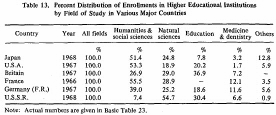
Note: Actual numbers are given III Basic Table 23. Basic Table 23
In this country, most university entrants obtain bachelor's degrees in the regular period of four years. Unlike Japan, however, very few students in the other major countries finish their first degree course in the regular period. Table 14presents the percent of students who have obtained degrees within the regular period within various major countries.
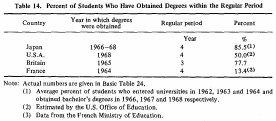
Note: Actual numbers are given in Basic Table 24. Basic Table 24 (1) Average percent of students who entered universities in 1962, 1963 and 1964 and obtained bachelor's degrees in 1966, 1967 and 1968 respectively.
(2) Estimated by the U.S. Office of Education.
(3) Data from the French Ministry of Education.
The proportion of female students in Japan was 28.4% in 1969, comparatively lower than in other major countries.
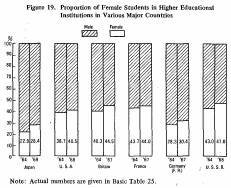
Note: Actual numbers are given in Basic Table 25. Basic Table 25
| Back to Top | MEXT HOME |